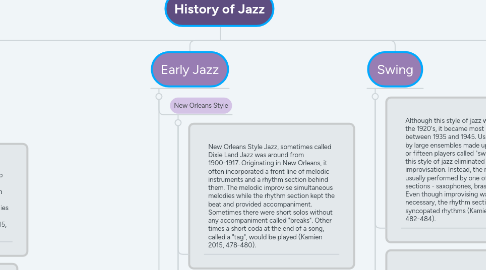
1. Roots
1.1. Ragtime
1.1.1. "Ragtime is a style of composed piano music that flourished from the 1890's to about 1915" (Kamien 2015, 473). This kind of music was usually written in duple meter and played fairly fast like a march. The normally syncopated melodies of ragtime influenced the improvised melodies of jazz musicians (Kamien 2015, 473-474).
1.1.2. Prominent composers and performers: Scott Joplin, Joseph Howard and Ida Emmerson
1.1.3. Maple Leaf Rag Played by Scott Joplin
1.2. Blues
1.2.1. Blues is a style of music originating from African American folk music. It is hard to find it's origin but it was regularly sung in the south during 1890's. At the time, "country blues" with a vocalist and guitar accompaniment had not been standardized and was not recognized. Jazz players borrow the style of the blues singers by trying to imitate vocalists during improvisational solos. They also use the same 12-bar format and chord progressions of blues to improvise melodies over in their jazz music (Kamien 2015, 474-478).
1.2.2. Prominent Composers and Performers: Bessie Smith, Muddy Waters and Robert Johnson
1.2.3. Bessie Smith (Nobody Knows You When You're Down And Out, 1929) Jazz Legend
2. Early Jazz
2.1. New Orleans Style
2.1.1. New Orleans Style Jazz, sometimes called Dixie Land Jazz was around from 1900-1917. Originating in New Orleans, it often incorporated a front line of melodic instruments and a rhythm section behind them. The melodic improvise simultaneous melodies while the rhythm section kept the beat and provided accompaniment. Sometimes there were short solos without any accompaniment called "breaks". Other times a short coda at the end of a song, called a "tag", would be played (Kamien 2015, 478-480).
2.1.2. Prominent Musicians: New Orleans Rhythm Kings, Louis Armstrong, and Jelly Roll Morton (Gushee, n.d.).
2.1.3. New Orleans Rhythm Kings-Tin Roof Blues
2.2. Chicago Style
2.2.1. During the 1920's a style similar to Dixieland jazz popped up in Chicago. It focused on improvising new melodies rather than improvising on the original melody. Multiple melodies gave this Chicago style jazz a polyphonic texture. This style is also significant because of the addition of the saxophone to the ensemble (Kamien 2015, 480).
2.2.2. Prominent Musician: King Oliver's Creole Jazz Band (Collier, n.d.).
2.2.3. Sobbin' Blues - King Oliver's Creole Jazz Band
